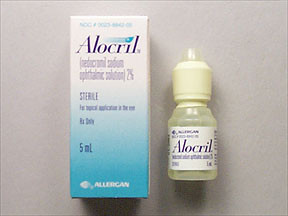NEDOCROMIL SODIUM - OPHTHALMIC
PHONETIC PRONUNCIATION: (neh-DOCK-row-mill)
COMMON BRAND NAME(S): Alocril
GENERIC NAME(S): nedocromil sodium
Uses
USES: This medication is used to treat itchy eyes due to allergies. Nedocromil works by reducing the release of natural substances in your body that cause an allergic reaction.
How to use NEDOCROMIL SODIUM - OPHTHALMIC
HOW TO USE: Read the Patient Information Leaflet that comes with this product before you start using nedocromil and each time you get a refill. If you have any questions regarding the information, consult your doctor or pharmacist. For best results, this medication should be used routinely, usually in each eye twice daily at evenly spaced intervals (every 12 hours) or as directed by your doctor. To help you remember, use it at the same times each day. Continue to use this medication as prescribed until pollen season is over or you are no longer exposed to the allergic substance, even when allergic symptoms disappear or improve. To apply eye drops, wash your hands first. To avoid contamination, do not touch the dropper tip or let it touch your eye or any other surface. Ask your doctor if you can wear contact lenses while you are being treated with this medication. If your doctor says you may continue wearing them, be aware that the preservative in this eye drop can be absorbed by your lenses. Remove your contact lenses before using the eye drops. Wait at least 15 minutes after each dose before putting in your lenses. Tilt your head back, look upward, and pull down the lower eyelid to make a pouch. Hold the dropper directly over your eye and apply 1 drop in the lower eyelid. Look downward and gently close your eyes for 1 to 2 minutes. Place one finger at the corner of your eye (near the nose) and apply gentle pressure. This will prevent the medication from draining out. Try not to blink and do not rub your eye. Repeat these steps for your other eye and if your dose is more than 1 drop. Do not rinse the dropper. Replace the dropper cap after each use, and keep the cap tightly closed. If you are using another kind of eye medication (e.g., drops or ointments), wait at least 5 minutes before applying other medications. Use eye drops before eye ointments to allow the eye drops to enter the eye. Inform your doctor if your condition persists or worsens.
Side Effects
Precautions
Interactions
Overdose
Images
Reviews
Faq for NEDOCROMIL SODIUM - OPHTHALMIC
NEDOCROMIL SODIUM - OPHTHALMIC is used to treat symptoms of allergic conjunctivitis, such as redness, itching, and watering of the eyes.
NEDOCROMIL SODIUM - OPHTHALMIC works by preventing the release of substances in the body that cause allergic reactions, thereby reducing inflammation and relieving symptoms.
NEDOCROMIL SODIUM - OPHTHALMIC is usually used 2-4 times a day, or as directed by your doctor. Tilt your head back, pull down your lower eyelid, and apply the prescribed number of drops into the eye. Close your eye and gently press your finger against the corner of the eye for about 1 minute to prevent the medication from draining out.
Common side effects of NEDOCROMIL SODIUM - OPHTHALMIC may include mild eye burning or stinging, headache, or blurred vision. If any of these symptoms persist or worsen, contact your doctor immediately.
NEDOCROMIL SODIUM - OPHTHALMIC should not be used while wearing contact lenses. Remove your contact lenses before using the medication and wait at least 10 minutes before reinserting them.
NEDOCROMIL SODIUM - OPHTHALMIC may be used in children, but the dosage and usage instructions may vary. Consult your pediatrician or doctor for appropriate guidance.
The effects of NEDOCROMIL SODIUM - OPHTHALMIC may not be immediate. It may take a few days of regular use for the medication to provide full relief from symptoms. If there is no improvement in your condition after a week, contact your healthcare provider.
There is limited information on the safety of NEDOCROMIL SODIUM - OPHTHALMIC during pregnancy or breastfeeding. It is recommended to consult with your doctor before using this medication if you are pregnant, planning to become pregnant, or breastfeeding.
NEDOCROMIL SODIUM - OPHTHALMIC is specifically intended for the treatment of allergic conjunctivitis. It should not be used to treat other eye conditions unless directed by a healthcare professional.
Disclaimer
IMPORTANT: HOW TO USE THIS INFORMATION: This is a summary and does NOT have all possible information about this product. This information does not assure that this product is safe, effective, or appropriate for you. This information is not individual medical advice and does not substitute for the advice of your health care professional. Always ask your health care professional for complete information about this product and your specific health needs.

No Reviews Yet